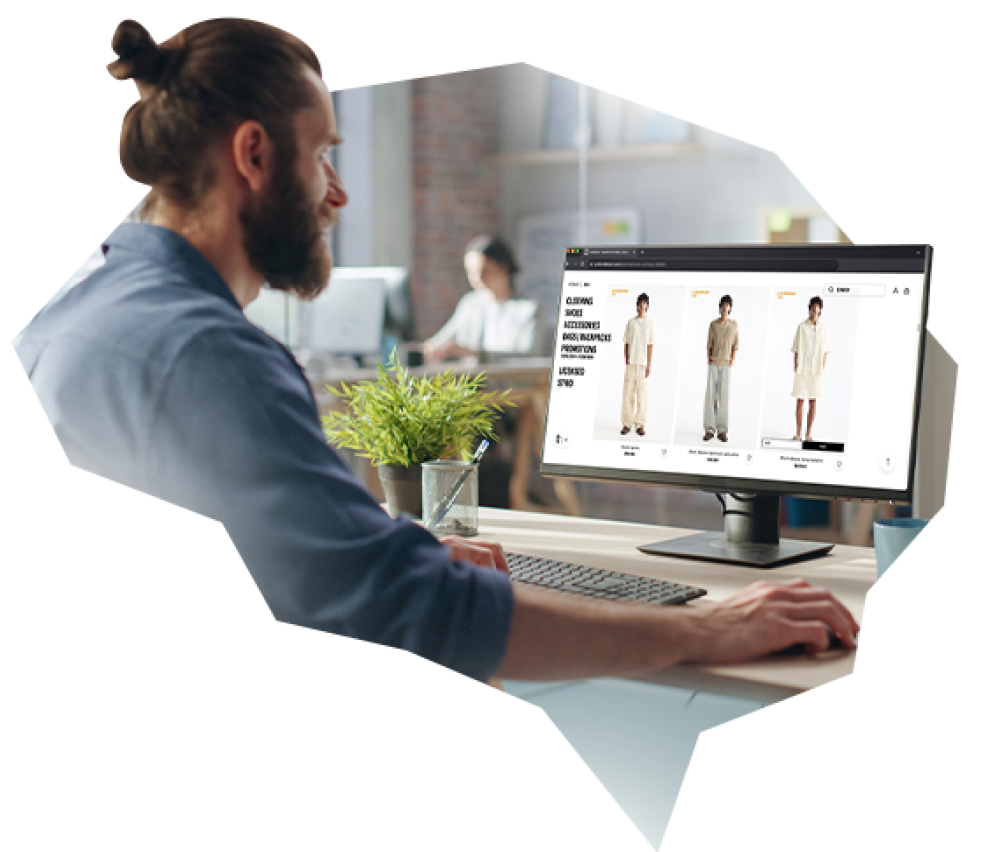Introduction

Envision entering a world where every detail of a corporate identity is shaped with precision and creativity. This is the world of the brand designer—a pivotal role that defines how a business is perceived in the eyes of its customers. In this dynamic arena, every color, shape, and font choice weave the narrative of a brand, turning abstract concepts into tangible experiences that resonate with audiences worldwide.
If your goal as an employer is to secure the best job description template available—one that you can seamlessly adapt for your own hiring needs—look no further. Below, we offer a direct download to our complimentary “Brand Designer Job Description” template. This document is crafted with the fundamental principles and top practices of C9Staff’s renowned hiring methodology, ensuring you have a robust foundation for drafting precise hiring specifications that meet the highest industry standards. Access this essential resource now to streamline your recruitment process and attract top talent.
Brand Designer Job Description Template

The significance of a well-crafted job description in this creative domain cannot be overstated. It is the blueprint that attracts the right architects—those gifted individuals capable of translating a company’s ethos into visual language that speaks clearly and effectively. A meticulously designed job description not only captures the essence of what is required for the role but also serves as the first point of engagement between a company and its future brand ambassadors.
Employers and job seekers, you are at the heart of this narrative. This guide is crafted to serve your distinct needs—whether you are drafting a job description that will catch the eye of exceptional talent or a creative professional seeking to make your mark in the world of brand design. Here, you will find insights and strategies tailored to elevate your understanding and execution of what makes a brand designer indispensable to a company’s success. Join us as we embark on a journey to master the craft of creating or fulfilling a brand designer job description. Together, we will explore how to harness creativity and strategic thinking to forge identities that are not only seen and admired but also felt and remembered.
Welcome to a journey of discovery and mastery in the art of brand design.
Branding in 4 Minutes: A Rapid Crash Course for Quick Mastery
What is a Brand Designer?

In the ever-evolving landscape of modern business, the brand designer emerges as a central figure in crafting corporate identities that resonate deeply with audiences. These professionals are more than just artists; they are pivotal players in strategic business success, blending creativity with business acumen to transform how a company presents itself to the world.
A brand designer’s role extends far beyond creating logos and color palettes. They develop the visual narrative that a company uses to connect with its customers, ensuring that every aspect of the brand’s visual representation aligns with its values and goals. This responsibility makes them crucial to a business’s ability to stand out in a crowded market.
Key Responsibilities of a Brand Designer
The responsibilities of a brand designer are diverse and impactful:
- Visual Identity Creation: Crafting logos, typography, color schemes that encapsulate the essence of the company.
- Brand Strategy Development: Collaborating with marketing teams to ensure that the brand’s design promotes its business goals and connects with the target audience.
- User Experience Enhancement: Designing visual elements that improve customer interaction with the brand through various mediums, which could include digital, print, and environmental graphics.
These responsibilities directly impact business success. For example, a well-designed logo and consistent branding can increase brand recognition, making it easier for customers to remember and choose the brand over competitors. Effective brand design can also enhance customer loyalty by ensuring all visual and interactive elements of the brand provide a positive, cohesive user experience.
Illustrative Examples of Impact
Consider a company like Apple, whose clean, minimalist design aesthetic is recognizable worldwide. This branding aligns perfectly with its reputation for high-quality, user-friendly technology, reinforcing customer loyalty and attracting new buyers. Similarly, Coca-Cola’s distinctive red and white lettering delivers instant brand recognition that continues to dominate the global beverage market.
Connecting Responsibilities to Job Descriptions
The profound impact of these responsibilities underscores the importance of crafting detailed and precise job descriptions for brand designers. A well-prepared job description not only outlines the necessary skills and experiences required for the role but also highlights the strategic significance of brand designers in achieving business objectives. It serves as the foundation for attracting talented individuals who can carry a company’s identity forward powerfully and persuasively.
Essential Skills and Qualifications for a Brand Designer

As we explore deeper into the world of brand design, it becomes clear that a successful brand designer is defined by a blend of technical skills and soft skills. These competencies are not just requirements; they are the foundations upon which effective brand identities are built, resonating deeply with audiences and driving business success.
Technical Skills
At the heart of a brand designer’s toolkit are technical skills that enable the creation of visually compelling designs. Proficiency in design software, particularly Adobe Creative Suite, is essential. This suite includes tools like Photoshop for image editing, Illustrator for vector graphics, and InDesign for layout which are indispensable for creating professional designs. But technical skills extend beyond software:
Typography: Understanding the power of type to communicate mood and tone is crucial. A well-chosen font can make a brand memorable and accessible.
Color Theory: Mastery of color theory helps designers create a palette that conveys the right emotions and values of the brand.
Digital and Print Media: Competence in both ensures that a brand’s identity is versatile and consistent across all platforms, from digital advertisements to printed brochures.
Each of these skills contributes to a designer’s ability to craft designs that not only look good but also serve a strategic business purpose, enhancing brand recognition and customer loyalty.
Soft Skills
Equally important are the soft skills that enable designers to work effectively within a team and solve problems creatively:
Communication: Effective communication ensures that ideas and visions are shared clearly between team members and clients, which is essential for the collaborative nature of design projects.
Creativity: At its core, brand design is a creative endeavor that requires originality and the ability to think outside the box.
Problem-Solving: Design challenges can be complex, involving multiple stakeholders with different views. A skilled designer must navigate these challenges with innovative solutions.
Teamwork: Designers often work in teams and must collaborate effectively with other departments to ensure that the brand’s vision is cohesive and well-integrated across all mediums.
These soft skills are manifested in daily interactions and project work, contributing directly to the operational success and strategic objectives of the business.
Educational and Professional Background
Typically, a brand designer will have a degree in graphic design or a related field. This educational background provides the theoretical and practical foundation required for high-level design work. However, the importance of a solid portfolio cannot be overstressed; it is the true testament to a designer’s capability, showcasing their best work and the breadth of their skills.
Certifications in specific design software or methodologies can also enhance a designer’s credibility and signify their commitment to their craft. For instance, being Adobe Certified can be a compelling indicator of expertise and proficiency.
Are you ready to supercharge your career and land your dream job? C9Staff is here to help you make that leap. By clicking the link below, you can submit your resume to our talent acquisition department. If your qualifications align with our client requirements, we will promptly reach out to discuss potential opportunities tailored to your expertise and career aspirations. Don’t miss this chance to connect with top employers and take your professional journey to the next level. Submit your resume today and let us help you find the perfect fit!

Crafting the Perfect Job Description for a Brand Designer

In your quest to attract and hire the ideal brand designer, crafting an articulate and enticing job description is a pivotal first step. This section will guide you through creating a job description that captures the essence of what it takes to excel as a brand designer and aligns perfectly with your company’s culture and values.
Writing a Compelling Job Summary Start by drafting a job summary that serves as the introduction to your company and the role of a brand designer within your team. This summary should quickly capture the attention of potential candidates by highlighting the unique opportunities and challenges of the position. Describe the central role the brand designer will play in your company, emphasizing their impact on overarching business goals and brand strategy.
Detailing Duties and Responsibilities The core of any job description is a clear and precise list of duties and responsibilities. For a brand designer, these might include:
Developing and maintaining the visual identity of the brand.
Collaborating with marketing teams to create cohesive designs for various campaigns.
Overseeing the production of digital and print marketing materials.
Ensure each responsibility is clearly defined to reflect the actual expectations and daily tasks associated with the role. This clarity helps candidates understand the scope of the position and self-assess their suitability.
Skills and Qualifications Next, outline the necessary skills and qualifications. Incorporate both the technical skills (like proficiency in Adobe Creative Suite and an understanding of web design principles) and soft skills (such as creativity, communication, and problem-solving) that are essential for success in this role. Be explicit about the level of experience required, whether it’s entry-level or more advanced, and any educational credentials that are preferred. This section helps set the bar for what candidates must bring to the table, ensuring a good fit for the role.
Benefits and Perks Highlighting the benefits and perks your company offers is crucial in attracting top talent. Detail aspects such as health insurance, retirement plans, professional development opportunities, and perhaps flexible working conditions. Show how these benefits reflect your company’s commitment to employee satisfaction and career development, which can be significant deciding factors for top candidates.
Reflecting Company Culture and Values Conclude the job description by integrating language and themes that convey your company’s culture and values. Whether your organization prides itself on innovation, creativity, sustainability, or community involvement, make these values clear. This not only helps attract candidates who align with these values but also promotes your company as a desirable place to work.
If your goal as an employer is to secure the best job description template available—one that you can seamlessly adapt for your own hiring needs—look no further. Below, we offer a direct download to our complimentary “Brand Designer Job Description” template. This document is crafted with the fundamental principles and top practices of C9Staff’s renowned hiring methodology, ensuring you have a robust foundation for drafting precise hiring specifications that meet the highest industry standards. Access this essential resource now to streamline your recruitment process and attract top talent.
Brand Designer Job Description Template

Benchmarking and Competitive Analysis in Brand Design

In this crucial section of our comprehensive guide, you will explore how to effectively use industry benchmarks to set competitive salaries and job perks for a brand designer. Understanding the importance of benchmarking in today’s competitive landscape is fundamental to attracting and retaining top talent.
The Importance of Benchmarking
Benchmarking is not just about staying competitive—it’s about being strategic in how you attract and manage talent. To start, gather data on salary ranges and benefits offered for similar roles within the industry. Utilize sources such as industry surveys, online salary databases like Glassdoor and Payscale, and insights from professional networks like LinkedIn. This process helps establish a baseline from which you can make informed decisions about compensation packages.
Analyzing Current Market Trends
Dive into the current trends affecting compensation and job expectations in the branding and design roles. The digital transformation has introduced a demand for new skills, such as digital branding and user interface design, which may warrant higher salaries due to their specialized nature. Additionally, the increase in remote work has shifted many companies’ perks and benefits, emphasizing flexibility over traditional incentives.
Understand how these trends are crucial for employers to attract and retain top talent. Staying current ensures that your job offerings are not only competitive but also relevant and appealing to today’s job seekers.
Case Studies from Leading Companies
To bring these concepts to life, consider the job descriptions from a diverse range of companies:
A Tech Startup: Might offer equity options and emphasize a culture of rapid innovation and flexibility.
A Large Corporation: Often provides a detailed career progression path and stability, with comprehensive health and retirement benefits.
A Creative Agency: Could highlight a vibrant office culture with perks like creative retreats, flexible hours, and wellness programs.
Each of these examples demonstrates how different environments and business goals affect the structure and content of job descriptions. Highlight how unique perks, such as work-from-home capabilities or continuous learning allowances, make these roles attractive and competitive.
Application of Benchmarking Data
Guide employers on how to use this benchmarking data to craft job descriptions that are not only competitive but reflective of current job market demands. This information is crucial for creating an offer that stands out and meets the expectations of skilled brand designers looking for new opportunities.
Strategic Hiring: Integrating Brand Designers into Your Team

In today’s multifaceted business environment, the strategic integration of brand designers into your team structure is more than just a staffing decision—it’s a crucial element in your overall business strategy. Brand designers do not merely create visually appealing designs; they play a key role in aligning these designs with the company’s marketing and business objectives, thus driving brand coherence and market relevance.
The Unique Value of Brand Designers
Brand designers bring a unique set of skills that transcends traditional artistry. They have the ability to think strategically about brand identity and ensure that every design decision supports the broader business goals. Their work impacts various aspects of the business, from product packaging to digital marketing, and requires them to collaborate across functions. This cross-functional collaboration between brand designers and departments like marketing, sales, and product development not only enhances the creative process but also leads to more cohesive and effective outcomes. By understanding and integrating the business’s core values and objectives into every design, brand designers help forge a stronger connection with the target audience.
Integrating New Hires into Existing Teams
Successfully integrating a new brand designer into an existing team is pivotal to maximizing their potential and the overall team’s output. Start with a structured onboarding process that includes comprehensive introductions to key team members, detailed overviews of ongoing projects, and a deep dive into the company culture. This initial phase is crucial for setting up new hires for success.
Consider the following actionable tips to enhance this integration:
Mentorship Programs: Pair new designers with experienced team members who can provide guidance, share insights, and help them navigate the company’s processes.
Initial Projects: Assign new hires small but significant projects that allow them to showcase their skills. This not only helps them gain confidence but also allows other team members to appreciate their style and thought process.
Regular Feedback and Collaboration Opportunities: Encourage a culture of feedback where new ideas are welcomed and discussed. This fosters a collaborative environment and helps new designers feel valued and understood.
Long-term Benefits of Effective Integration
The long-term benefits of effectively integrating brand designers into teams are manifold. Firstly, it leads to increased innovation as fresh ideas and perspectives challenge the status quo and drive creativity. Secondly, it ensures stronger brand consistency as the designer becomes more attuned to the company’s branding strategy. Lastly, it enhances team morale and fosters a collaborative work environment that values each member’s contributions.
For Job Seekers: Tailoring Your Application

Navigating the competitive field of brand design requires more than talent—it demands a strategic approach to presenting your skills and experiences. This section of our guide provides crucial insights into tailoring your resume and portfolio to effectively meet the specific demands of a brand designer job description.
Understanding the Job Description
The first step in tailoring your application is to thoroughly understand the job description. It’s crucial to identify what potential employers are specifically looking for, from technical skills to the type of brand design experience valued. Aligning your application with these requirements can significantly increase your chances of securing an interview.
Customizing Your Resume
Here’s how you can customize your resume for a brand design position:
Highlight Relevant Experience: Carefully select and feature experiences that align directly with the job description. If the role calls for experience in rebranding corporate identities, include specific projects where you successfully rejuvenated a company’s image.
Showcase Technical Skills: List essential technical skills, such as proficiency in Adobe Creative Suite or Sketch, that are crucial for the role. Make sure these skills are easily noticeable and match those listed in the job description.
Emphasize Soft Skills: Include soft skills like creativity, teamwork, and communication, particularly if they are highlighted in the job description. These are often as important as technical abilities and demonstrate your capability to integrate into the company’s culture.
Crafting Your Portfolio
Your portfolio is a visual testament to your skills and creativity. Here’s how to optimize it:
Selecting Portfolio Pieces: Choose pieces that showcase your expertise in areas highlighted in the job description. This could include a mix of media like logos, digital layouts, or comprehensive branding projects. Ensure that each piece is relevant to the role you’re applying for.
Narrative and Context: For each project, include a brief description that outlines the objectives, your role, challenges faced, and the solutions you provided. This narrative helps potential employers understand the context and impact of your work.
Standing Out in Brand Design
To stand out in the field of brand design:
Personal Branding: Develop a strong personal brand that reflects your design philosophy and professional ethics. This can be communicated through a unique personal statement or a well-designed personal website.
Networking: Engage with the industry through platforms like LinkedIn, and participate in design conferences and workshops. Networking can open doors to opportunities and provide insights into industry trends and demands.
If you’re looking to find the perfect candidate for a Brand Designer position within your organization, C9Staff is here to assist you every step of the way—from sourcing to deployment. By clicking the link below, you can schedule a free exploratory call with one of our experienced account managers today. During this call, we’ll carefully listen to your specific needs and recommend potential candidates at no cost, helping you evaluate the best talent available at competitive prices. Don’t miss this opportunity to enhance your team with top-tier professionals tailored to your requirements.

Conclusion: Harnessing the Power of Precision in Brand Design

As we conclude our comprehensive guide, “Mastering the Craft: The Ultimate Guide to Creating a Brand Designer Job Description,” we reflect on the pivotal journey you, the reader, have embarked upon. From understanding the critical role of brand designers to delving into the intricacies of crafting the perfect job description, this guide has covered essential elements to empower both employers and job seekers in the dynamic field of brand design.
The Importance of Detailed Job Descriptions
We’ve emphasized the necessity of precise and detailed job descriptions throughout this guide. For employers, such clarity in job descriptions streamlines the hiring process and ensures that only the most suitable candidates are considered, thereby ensuring a good fit. For job seekers, these detailed descriptions provide clear guidance on what is expected in potential roles and how best to tailor applications to meet these expectations. This dual benefit not only enhances the efficiency of the hiring process but also significantly improves the quality of job matches in the competitive design market.
Encouragement for Continuous Learning and Adaptation
In the ever-evolving landscape of brand design, continuous learning and adaptation are not just beneficial; they are essential. Both employers and job seekers must stay abreast of the latest technologies, design trends, and industry standards to maintain competitiveness and relevance. This guide encourages all parties to view ongoing changes and shifts in the industry as opportunities for personal and professional development. Engaging actively with new tools, methodologies, and learning platforms can lead to sustained success and growth in the field of brand design.
As we draw this guide to a close, let this not be the end of your learning journey but rather a beginning. The insights and strategies detailed here are tools for you to navigate the complexities of hiring and career development in brand design. Use this knowledge to approach the challenges and opportunities of this field with confidence and creativity.
Let us part with a call to action: Engage continuously with the practices and insights shared. Whether you are drafting job descriptions or tailoring your applications, strive for precision and innovation. Let the principles of good design guide you—not just in creating visuals but in forging your path in the professional world.
Armed with the knowledge from this guide, step forward into the world of brand design with determination and enthusiasm, ready to make impactful decisions that will shape your career and influence the industry. Your journey in mastering the craft of brand design continues, and may each step you take be informed, inspired, and ingenious.




